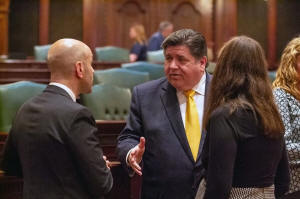Pritzker’s budget office projects $3.2B deficit in early look at
upcoming fiscal year
 Send a link to a friend
Send a link to a friend
 [November 05, 2024]
By Jerry Nowicki [November 05, 2024]
By Jerry Nowicki
The first extensive public look at next year’s state finances contains a
warning to lawmakers from the governor’s office: “The ability to fund
new programs will be severely limited” next fiscal year.
That comes from the Governor’s Office of Management and Budget, which
projected a potential budget shortfall of $3.2 billion for fiscal year
2026, which doesn’t begin until July 1.
The Illinois Economic and Fiscal Policy Report published each November
is often seen as a table-setter for the budgeting negotiations that will
ramp up in earnest when lawmakers return to the Capitol for the
legislative year that begins each January.
GOMB projects that revenues will remain flat at roughly $53.4 billion
for the upcoming year, while spending will grow by $3.2 billion.
While the overall numbers can change quickly in the eight months between
now and the start of fiscal year 2026, the report could forebode an even
more challenging budget process than the one that wrapped up in May.
Lawmakers entered last year’s session staring down a roughly $891
million deficit, according to last year’s GOMB report.
After lengthy and sometimes fraught deliberations, Democrats in power
narrowly approved a budget that filled the gap by extending a cap on
corporate net operating losses ($526 million), capping a tax discount
claimed by retailers ($101 million), increasing the state’s tax on
sports betting ($200 million) and other smaller accounting measures or
tax changes.
As for the impending $3.2 billion deficit, the report noted only it
“will be addressed in the Governor’s Fiscal Year 2026 Introduced
Budget.”

But, the report noted, spending reductions “cannot be implemented
broadly across-the-board,” especially for the 40% of spending that is
mandated either by court order, law or other obligations, such as debt
service, pension payments and Medicaid. Another 24% of state spending
goes to areas such as education and higher education.
‘True-up’ drives revenue stagnation
The expected deficit is attributable in part to both rising expenditures
and revenue stagnation as some one-time sources disappear.
The projected spending for FY 26 includes an additional $350 million to
K-12 education, while pension costs are expected to increase by $440
million among other “moderate growth” in state spending across the
board.
Health care costs are expected to grow by $1.1 billion, due in part to
“the impact of medical inflation and drop off of one-time FEMA (Federal
Emergency Management Agency) reimbursement revenues” for Medicaid and
state health care plans. FEMA had still been reimbursing some
pandemic-era costs borne by state government, according to the
governor’s office, but that’s expected to drop off in the upcoming
fiscal year.
Revenues are expected to stagnate in part because of a “true-up” process
at the Illinois Department of Revenue that has temporarily inflated
state coffers over the past two years, stemming from a complicated
miscalculation by the department.
In short, IDOR overdistributed the amount of money collected in
Corporate Property Replacement Taxes – which primarily go to local
governments – in tax year 2021 by about $800 million. Corporate income
taxes were overestimated by $200 million, while individual income taxes
from pass-through entities were underestimated by $1.1 billion. The
miscalculation, according to IDOR, “was caused by tax policy changes,”
at the federal and state level affecting businesses.

[to top of second column]
|

Gov. JB Pritzker talks with lawmakers on the floor of the Illinois
House in April. His office last week issued a report projecting a
$3.2 billion deficit for the fiscal year that begins in July.
(Capitol News Illinois photo by Jerry Nowicki)

The department began a “true-up” process in fiscal years 2024 and 2025
that is aimed at fixing the “overpayments” to local governments while
boosting state general revenues in the process.
It’s had the effect of driving general revenues up by about $1 billion
in each of fiscal years 2024 and 2025.
But the same won’t happen in FY26, the legislature’s Commission on
Government Forecasting and Accountability noted in its September report,
because IDOR adjusted its disbursement percentages in 2023.
As a result, COGFA noted, general fund receipts could be “notably
weaker” in the upcoming fiscal year – and GOMB’s report indicates the
same.
Revenues are also expected to slow as the Federal Reserve decreases
interest rates, lowering the state’s investment income.
The state is also entering the final step of a five-year process of
shifting the sales tax collected on motor fuel from the General Revenue
Fund to the Road Fund. That shift was included in Pritzker’s first
budget in 2019 as part of the Rebuild Illinois infrastructure plan.
Still, the report projects about $1 billion combined growth in corporate
and personal income tax, while sales taxes are projected to fall by $330
million, marking a mixed bag for the state’s “big three” revenue
sources.
A history of surpluses
What comes of the projected deficit and how it is defrayed will be up to
the governor and the new General Assembly that is seated in January.
Thus far in his tenure, Pritzker’s administration has shown that it can
work with lawmakers to balance the books. Every year since the COVID-19
pandemic upended state finances in 2020, the state has seen significant
surpluses. Those occurred for several reasons, including
better-than-expected revenues as consumers spent more on goods, and
government stimulus checks that boosted the economy.
Some years have been buoyed by one-time factors, such as the “true-up”
process of the past two years and the state’s retroactive collection of
Medicaid dollars in fiscal year 2024.
But the surpluses are also partially attributable to the Pritzker
administration’s conservative estimates early in the budgeting process.
In past years, that allowed lawmakers to kick extra revenues to the
state’s “rainy day” fund that now has a record balance of $2.2 billion
while paying down about $11 billion worth of outstanding debts.

Late payment interest expenditures have dropped from about $980 million
at the height of the state’s two-year budget impasse between Republican
Gov. Bruce Rauner and Democrats in the General Assembly in fiscal year
2018, to $137 million in Pritzker’s first year in office and $13 million
last fiscal year.
The forecast from GOMB anticipates a surplus for the current year as
well, prior to next year’s deficit. Personal income tax and interest
income have been higher than expected, while corporate income taxes are
coming in lower than originally projected, mirroring national trends.
All told, the state is now looking at a $262 million current-year
surplus, according to the report, but $246 million of that would be
reserved in the Budget Stabilization, or “rainy day” fund.
Capitol News Illinois is
a nonprofit, nonpartisan news service that distributes state government
coverage to hundreds of news outlets statewide. It is funded primarily
by the Illinois Press Foundation and the Robert R. McCormick Foundation. |